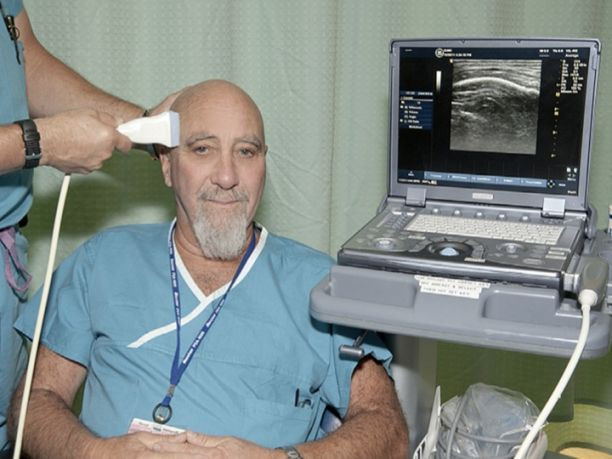Brain Ultrasound Boosts Mood Levels: ‘I Started To Feel Like I'd Had A Martini’

When applied to specific areas of the brain, ultrasound waves have the remarkable ability to elevate a person's mood levels, causing them to feel "lighter" and "happier," reports a group of researchers from the University of Arizona (UA).
The ultimate goal in developing transcranial ultrasound (TUS) is treating people with psychological and psychiatric disorders, such as depression and posttraumatic stress disorder (PTSD). Further down the line, the researchers hope to create a noninvasive headset that the user can wear at his or her leisure.
Professor emeritus at UA's anesthesiology and psychology departments, Dr. Stuart Hameroff, is the lead author in the study and the first to conduct a clinical trial on the technology behind brain ultrasound on humans.
The One-Minute Martini
Knowing that ultrasound vibrates in megahertz frequencies of 10 vibrations per second just like the brain's microtubules — protein structures linked to mood and consciousness — Hameroff wondered if passing an ultrasound through a person's brain could affect mood levels.
"I said to my anesthesiology colleagues, 'we should try this on chronic pain patient volunteers,'" he said, although his colleagues respectfully suggested that he try it on himself first.
Hameroff ran an ultrasound transducer over his scalp, but experienced no immediate effect. Then a minute passed.
"I put it down and said, 'well, that's not going to work.' And then about a minute later I started to feel like I'd had a martini," he said, adding that he felt a mood elevation for the next hour or two. But like any experienced researcher, Hameroff knew full well the effect could be a placebo. He knew he needed a clinical trial.
After receiving the necessary hospital approval and patient consent, Hameroff and his colleagues recruited chronic pain patients from the University of Arizona Medical Center-South Campus. The study performed was double-blind, meaning neither the doctor nor the subject knew if the ultrasound machine was turned on.
The team's findings mirrored Hameroff's initial test on himself. Patients reported mood improvements for up to 40 minutes after the TUS, with no effects being reported from the group whose machine was turned off.
TUS In The Future
Hameroff called the findings "encouraging," particularly because other technologies that accomplish a similar task are far more invasive and potentially more discomforting than TUS. Transcranial magnetic stimulation (TMS), for instance, passes a magnetic wave through the skull in order to treat depression; however, the sensation of a magnetic wave can be unpleasant for patients.
Due to its high-frequency vibrations, ultrasound is inaudible to the human ear. It is also harmless at low intensity.
"We frequently use ultrasound in the operating room for imaging," said Hameroff, reflecting on the wave's abilities to bounce around inside the body like an echo to produce a picture. "It's safe as long as you avoid excessive exposure and heating."
For all the compelling results of his first study, Hameroff wanted to refine his testing. "I'm not a skilled clinical psychologist, plus we were very limited in clinic time," he said. "So I got two of my colleagues, Jay Sanguinetti and John Allen, to join in and help out."
The three set up another test, wherein they found 2 MHz for 30 seconds was the optimal condition for mood elevation.
"With 2 megahertz those who were stimulated with ultrasound reported feeling 'lighter,' or 'happier;' a little more attentive, a little more focused and a general increase in well-being," Sanguinetti said.
What's happening scientifically, the researchers believe, is the ultrasound makes the neurons fire more actively in the parts of the brain associated with mood; thus, the brain's electrical activity changes and patients report feeling better.
Moving forward, the UA team has partnered with Silicon Valley-based company Neurotrek to develop a wearable device for users that could send bursts of ultrasound to designated spots in the brain. The researchers are currently working with Neurotrek on building such a prototype.
"As microtubules are intimately involved in synaptic plasticity, and theoretically implicated in learning, memory and conscious experience...TUS may be useful in a variety of mental and neurological disorders," the researchers concluded, "including depression, traumatic and hypoxic brain injury, stroke, learning, Alzheimer's disease, psychiatric disorders, and altering states of consciousness."
Source: Hameroff S, Trakas M, Duffield C. Transcranial ultrasound (TUS) effects on mental states: A pilot study. Brain Stimulation. 2012.
Published by Medicaldaily.com



























